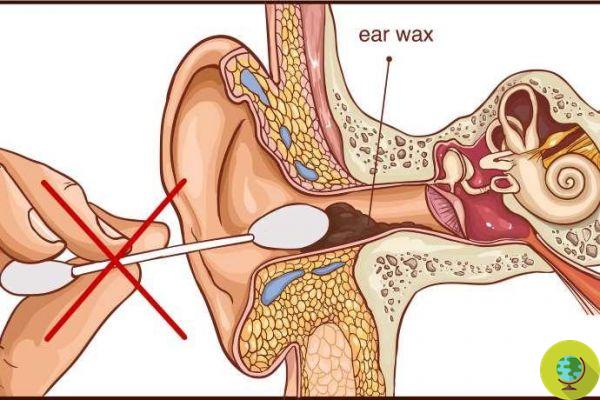
Earwax is a mixture of substances located in the external auditory canal, which we tend to clean for hygiene and which in some cases, if excessive, can cause a lot of discomfort, to the point of forming real plugs that must be removed by expert personnel. But why do we have it?
Don't store avocado like this: it's dangerous
Earwax is a mixture of substances located in the external auditory canal, which we tend to clean for hygiene and which in some cases, if excessive, can cause a lot of discomfort, to the point of forming real plugs that must be removed by expert personnel. But why do we have it?
The secretion is physiologically pushed by the epithelial cells towards the outside of the ear canal, and the movements of the mouth during chewing, conversation or yawning also contribute to this natural process.
Many people tend to clean their ears by removing earwax even using cotton swabs, thinking it is a hygienic measure to take. Nothing could be more wrong: the sticks, in addition to being an environmental problem, can in turn cause damage to the ear and are used to remove something that, instead, is anything but a problem.
Index
The beneficial properties of earwax
Earwax may seem synonymous with dirt, but in reality a defense of our body without which our ears would not be properly lubricated, nor protected from unwanted guests such as dirt or debris.
As has long been known, the secretion also has antibacterial and antifungal properties as it keeps the environment in the ear canal acidic and forms a physical barrier against foreign substances such as water, insects and dust.
Types of earwax
Earwax is not the same for everyone. Chemically composed of fatty acids, alcohols, ceramides, triacylglycerols, long chain hydrocarbons and cholesterol precursors such as lanosterol and squalene, as well as cholesterol itself, it can manifest physical consistency ranging from wet, sticky and yellow / brown to dry, crumbly and white / greyish.
These differences have genetic roots: in particular, "wet" ear wax is formed with a gene called ABCC11, and this is so true that different ethnic groups have selected different types in the course of evolution.
In particular, the dry type is usually prevalent in East Asians (95%) but rare in Europeans and Africans (3%), while a mixed rate of dry and wet types with an incidence of dry wax of 30-50% is observed in the populations of Native North Americans, in the Pacific Islands, Central Asia and Turkey.
Plug of earwax
Excess ear wax is usually eliminated from the body naturally. In some cases, however, there may be a excessive accumulation. The secretion is in fact produced in different quantities also based on environmental factors such as stress. In addition, some people have a narrow or slightly bent ear canal, which is not conducive to its exit.
In these cases, what is commonly known as “ear plug” forms, which in some cases can seriously compromise hearing, hindering the sound waves, which are unable to reach the eardrum effectively. Everything is perceived much more muted and also an annoying experience is experienced ear pain.
How to remove ear wax (and what not to do)
There are several methods for the physical elimination of ear wax when it is decidedly excessive, so as to compromise hearing: from substances that dissolve it to make it drop in the ear canal to the insertion of pressurized water into the ear canal.
However, it is important that these operations are done by expert staff because the risks are very high: an incorrect use of equipment, for example, could also lead to injury to the eardrum.
In general, it is therefore good to use soap and water for personal hygiene of the ears and for any doubts always contact a doctor.
You can find out here how to clean your ears without using cotton buds.
Read also:
- 5 simple natural remedies for ear pain
- How to get rid of water from your ears
Roberta de carolis


























